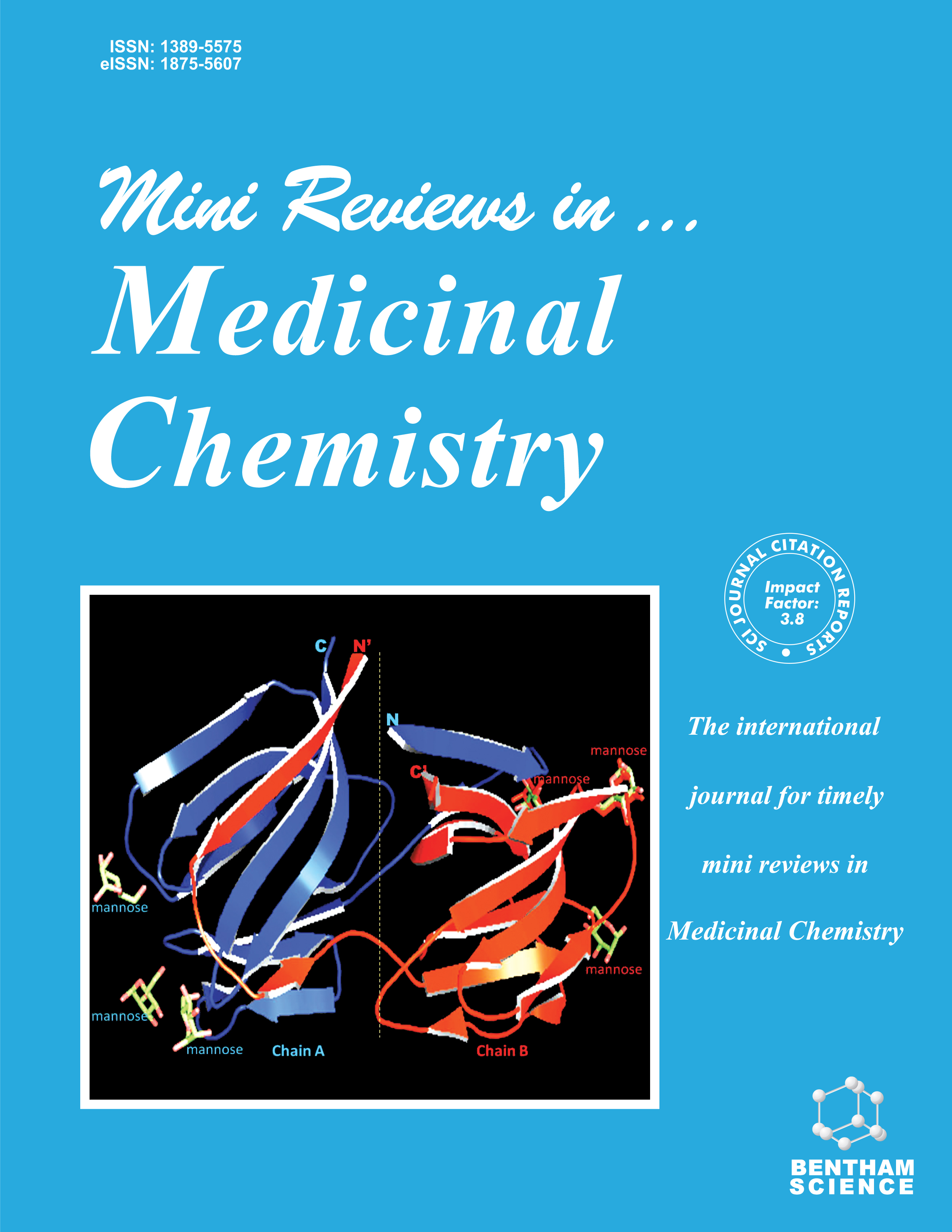Mini Reviews in Medicinal Chemistry - Volume 25, Issue 6, 2025
Volume 25, Issue 6, 2025
-
-
Exploring the Versatility of Azine Derivatives: A Comprehensive Review on Synthesis and Biological Applications
More LessAuthors: Saeed M.N. Alasmari, Aftab Alam, Fayaz Ur Rahman, Ahmed A. Elhenawy, Abid Ali, Manzoor Ahmad and Momin KhanOrganic compounds containing azines, di-imines, or bis-Schiff-bases have two azomethine (-CH=N-) functional groups associated with a bridging component. These constituents have attracted attention from a diversity of disciplines, comprising coordination, medicinal, agriculture chemistry, and organic synthesis, because of their comprehensive chemical reactivity and nature. This study determines common synthetic approaches and various biological and pharmacological activities of several substituted bis-Schiff byproducts. The usefulness of bis-Schiff bases in synthetic chemistry and their potential as inhibitors of a number of enzymes have attracted research attention. We have examined different biological activities and common synthetic methods used to make bis-Schiff bases that have been published in the literature. A systematic search of the literature has been performed, and studies fitting the prearranged inclusion standards have been inspected. This review can open up new potentials for upcoming research in this area and advance our information on bis-Schiff bases.
-
-
-
An Outline on Benzimidazole Containing Marketed Drugs with Proton Pump Inhibitor and H1 Receptor Antagonist Activities
More LessAuthors: Sumit Tahlan, Sucheta Singh, Kailash C. Pandey and Kuldeep SinghHeterocyclic compounds are increasingly used in medicinal chemistry because they are the main components of many biological processes and materials. Benzimidazole remains the core center of the heterocyclic chemical group, with essential traits such as six-five-member connected rings and two nitrogen atoms at the 1,3 position in a six-membered benzene and five-membered imidazole-fused ring system. Molecules with benzimidazole derivatives serve important functions as therapeutic agents and have shown excellent results in clinical and biological research. In this comprehensive review, we summarize marketed medications that include the benzimidazole moiety. Here, we discuss two topics: PPIs and H1 receptor antagonists. Benzimidazole derivatives are important in all fields because they have the same isostructural pharmacophore as that of naturally occurring active biomolecules. While PPIs and H1 receptor antagonists are generally safe in the short term, accumulating data suggest that their long-term use may pose concerns. This systematic review aimed to assess global PPI use in the general population. This will help researchers, medicinal chemists, and pharmaceutical scientists to create breakthrough benzimidazole-based drugs. This review can help identify novel lead compounds and optimize existing benzimidazole derivatives to improve medicinal efficacy. Benzimidazole has attracted significant interest because of its high bioavailability, stability, and biological efficiency. This page reveals and discusses typical synthesis processes for marketed pharmaceuticals in the benzimidazole class of scaffolds, MOA, and therapeutic uses.
-
-
-
Implications of Biomaterials for Chronic Wounds
More LessThe use of biomaterials in treating and managing chronic wounds represents a significant challenge in global healthcare due to the complex nature of these wounds, which are slow to heal and can lead to complications such as frequent infections and diminished quality of life for patients. Chronic wounds, which can arise from conditions like diabetes, poor circulation, and pressure sores, pose distinct challenges in wound care, necessitating the development of specialized dressings. The pathophysiology of chronic wounds is thoroughly examined in this article, with particular attention paid to the cellular and molecular defects at work and the therapeutic guidelines. It also identifies key issues in the field, such as biocompatibility, cost-effectiveness, immune reactions, and regulatory obstacles, while suggesting future research focuses on improving biocompatibility, integrating drug delivery systems, and exploring cellular treatments. Ethical implications, such as patient safety, informed consent, and equitable access to technology, are also discussed. Finally, this review highlights the transformative potential of biomaterials in chronic wound management, urging for continued research and clinical integration to fully harness their capabilities in improving patient care.
-
-
-
New Insights into the Modifications and Bioactivities of Indole-3-Carboxaldehyde and its Derivatives as a Potential Scaffold for Drug Design: A Mini-Review
More LessIndole, a ubiquitous structural motif in bioactive compounds, has played a pivotal role in drug discovery. Among indole derivatives, indole-3-carboxaldehyde (I3A) has emerged as a particularly promising scaffold for the development of therapeutic agents. This review delves into the recent advancements in the chemical modification of I3A and its derivatives, highlighting their potential applications in various therapeutic areas. I3A derivatives have demonstrated a wide range of biological activities, including anti-inflammatory, anti-leishmanial, anti-cancer, anti-bacterial, anti-fungal, and anti-HIV properties. The structural modifications introduced to the I3A scaffold, such as substitutions on the indole ring (alkylation/arylation/halogenation), variations in the aldehyde group via condensation (Aldol/Claisen/Knoevenagel), and molecular hybridization with other reputable bioactive compounds like coumarins, chalcones, triazoles, and thiophenes, contribute to these activities. Beyond its therapeutic potential, I3A has also found applications as a ligand for Schiff base synthesis, a polymer, and a chromophore. This review provides a comprehensive overview of the latest research on I3A and its derivatives, focusing on the key reactions, modification pathways, reaction conditions, yields, and associated therapeutic activities. By understanding these advancements, researchers can gain valuable insights into the potential applications and future directions for I3A-based drug discovery.
-
Volumes & issues
-
Volume 25 (2025)
-
Volume 24 (2024)
-
Volume 23 (2023)
-
Volume 22 (2022)
-
Volume 21 (2021)
-
Volume 20 (2020)
-
Volume 19 (2019)
-
Volume 18 (2018)
-
Volume 17 (2017)
-
Volume 16 (2016)
-
Volume 15 (2015)
-
Volume 14 (2014)
-
Volume 13 (2013)
-
Volume 12 (2012)
-
Volume 11 (2011)
-
Volume 10 (2010)
-
Volume 9 (2009)
-
Volume 8 (2008)
-
Volume 7 (2007)
-
Volume 6 (2006)
-
Volume 5 (2005)
-
Volume 4 (2004)
-
Volume 3 (2003)
-
Volume 2 (2002)
-
Volume 1 (2001)
Most Read This Month


